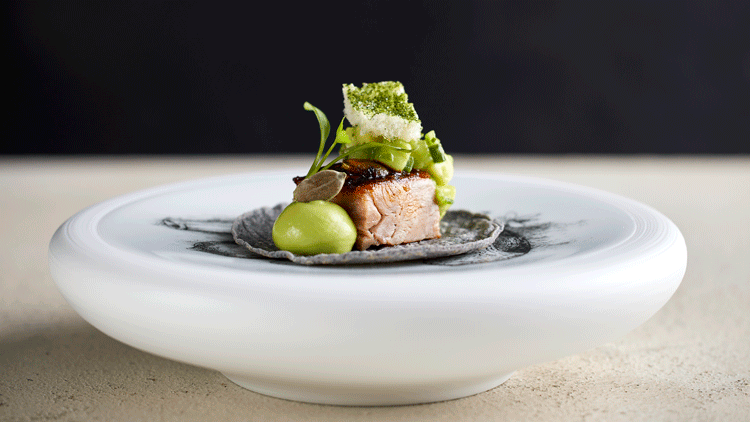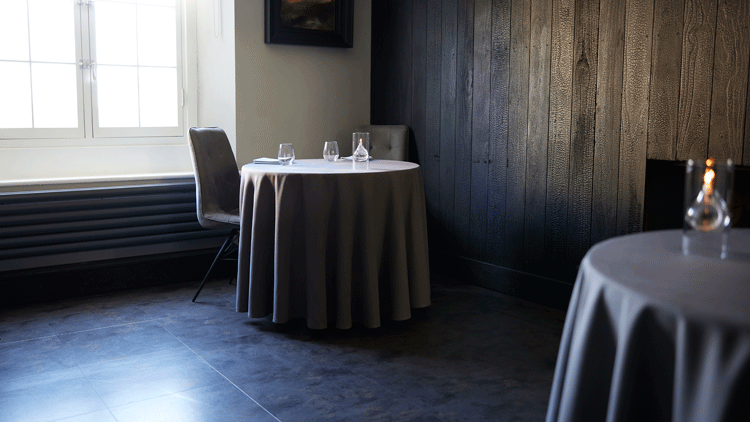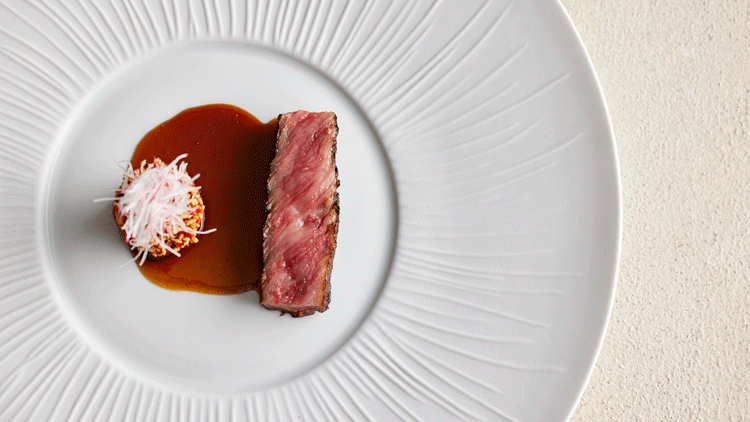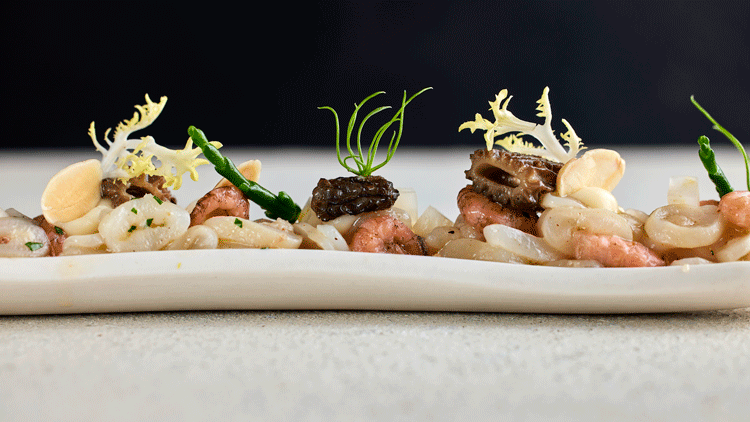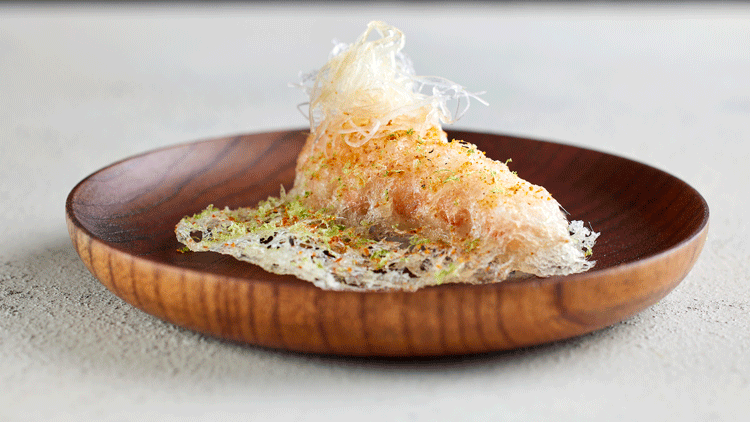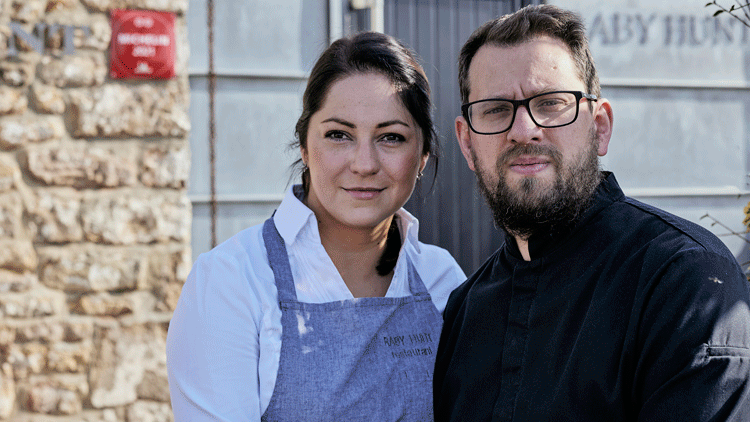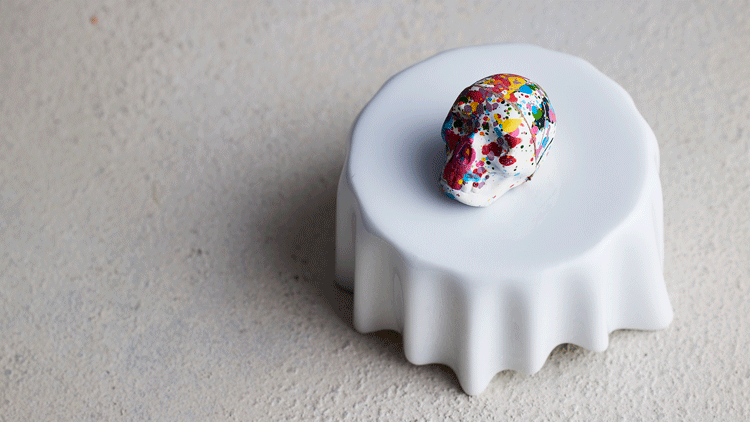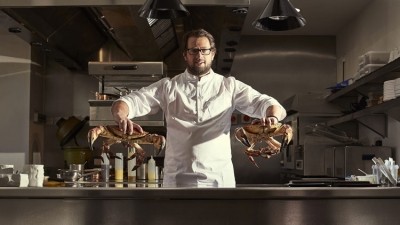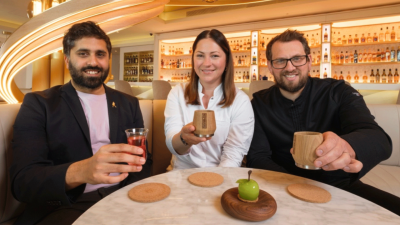How an untrained Country Durham chef created one of the UK’s most exciting restaurants
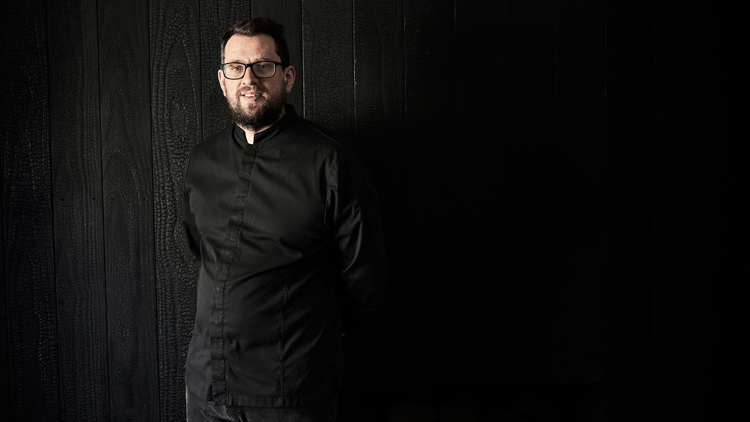
Meals at The Raby Hunt start with a succession of one or two-bite snacks. There's nothing unusual about that, but while most chefs deliver their opening salvo within the first 10 minutes or so of a meal, James Close devotes over an hour to it.
It is, the chef says, an acknowledgement that the part of the meal that takes place before the knives and forks hit the table is nearly always the most engaging. “People are hungry and excited and enjoying that first buzz of alcohol. It’s high-energy.”
Holding people’s attention for that length of time with a glass of champagne and just seven morsels is no small feat but Close – who is nearly entirely self-taught – makes it look effortless. Inspired by world cuisine, the snacks include a suckling pig taco; a ceviche-filled lime; and a one-bite burger of foie gras and house-made pastrami that is an ode to the street food of New York.
A globally-themed series of dishes may sound like an odd choice given The Raby Hunt’s not very cosmopolitan location – the restaurant is in the village of Summer House about 15 minutes’ drive from Darlington – but Close’s understanding of flavour profile and technique is captivating enough to make this mini world food tour make sense.
“I didn’t even know what Michelin was until I’d done a year or so here. But I soon became obsessed with it and started to seek out the really top-end places both in the UK and aboard”
Accessible fine dining
As well as showcasing the kitchen’s unquestionable culinary prowess, The Raby Hunt’s first flurry of dishes is a play to make top-flight dining more accessible. The Country Durham restaurant may now hold two Michelin stars, but its location means it still pulls in a lot of diners looking for something recognisable and perhaps a little more down-to-earth than what is served in some multi-Michelin-starred dining rooms.
"The flavours are largely based on the sort of food I want to eat on my days off,” says Close. “The problem is there's only so much of that style of eating people can take. The palate gets tired out by all those punchy flavours. Eventually you have to move on to the more refined, larger dishes.”
The latter portion of The Raby Hunt’s £240 15-course tasting menu is more straightforward in feel but still packs a punch thanks to Close’s focused approach – dishes rarely contain more than a few elements – and commitment to sourcing the very best.
Dishes from the middle part of the menu include razor clam with almond, brown shrimp and celeriac; and Herdwick lamb with wilted lettuce and black truffle while the final sweet section – of which Close’s pastry chef wife Maria has full autonomy – includes a high-end take on pavlova and The Raby Hunt’s famed petit fours (see Skullduggery: The Raby Hunt's chocolate skulls).
Making up for lost time
A former pro golfer, Close swapped his driver for a chef’s knife in his late twenties when he realised he didn’t quite have what it took to reach the very top rungs of the sport. As a result, he only discovered the joys of high-end dining relatively late on.
“I didn’t even know what Michelin was until I’d done a year or so here," admits Close, who started out at the handful of Michelin-starred pubs within striking distance of his restaurant. "But I soon became obsessed with it and started to seek out the really top-end places both in the UK and aboard.”
“Two ingredients on the plate and an amazing sauce is often all you need”
Initially, Close was preoccupied with the techniques used by multi-starred chefs but - following an epiphany at chef Arnaud Donckele’s three-star La Vague d’Or in Provence - now goes to hallowed restaurants to sniff out new ingredients and because he and Maria enjoy it.
“It was a dish of duck with plums. At first, I thought ‘is that it?’ but when I tasted it, I got it. Two ingredients on the plate and an amazing sauce is often all you need.”
The Closes are now prolific high-end restaurant goers, choosing to spend what little free time they have in European three-stars (France and Germany in particular). Close is interested in both classical and contemporary cooking but admits to having a weakness for the former due to his geekery over sauce making.
This considerable eating out experience has taught him that simple is nearly always best. Close believes that too many chefs, even well-trained ones, tend to try and show off on the plate. “There are very few chefs that can pull off dishes with lots of different elements. It’s like trying to play football like Messi. There are a handful of people that can do it, but you need to leave it to them.”
Close has always manned the stove at The Raby Hunt but was initially under the instruction of his former hotelier-mother, with whom he took on the business in 2009. Amazingly, it is the only the only kitchen he has ever known.
Armed with a library of cookbooks and those early experiences of eating at top end restaurants, the novice chef soon started to develop the food. Though he cringes at some of his early efforts, it wasn’t long before he developed a loyal local following for his cuisine. The restaurant’s first star was a bit of a surprise arriving in 2012 just three years after he first donned his whites with a second, awarded in 2016, cementing The Raby Hunt's formidable reputation for food.
While he may have been ignorant of Michelin at the start, with two stars to his restaurant's name he is no longer. Quite the opposite, in fact, with Close admitting to having had at one point an unhealthy obsession with the red book in terms of both keeping his current rating and pushing for a third, although in recent years has tried his best to relax.
“I'd be lying if I said I didn’t have Michelin on my mind. I do. But it’s not something I want to get worked up about anymore. There are other things in my life. I have a daughter and Maria and I will probably have children of our own soon. Being obsessed about whether Michelin is coming or not coming or what they might do was ruining things for me.”
A lack of experience
Having now been cooking at The Raby Hunt for 13 years, Close can no longer be described as an inexperienced chef. He does however still feel he’s lacking when compared to his multi-Michelin-starred peers that have spent decades climbing the culinary ladder.
“I've got no idea what I'm doing or why I'm doing it,” the 42-year-old laughs. “Early on I tried to hire people with more experience than me, but they put me off. They would come in and just look at me and go 'what is this guy doing?’ Let’s not lie about it they had a point; it was absolutely rubbish in the early days.”
He soon switched over to people with little to no experience but now seeks to recruit chefs from other top-end places. “I have more confidence now. I want people who can come and show me something new.”
“Early on I tried to hire people with more experience than me, but they put me off. They would come in and just look at me and go ‘what is this guy doing?’”
Not having had decades of experience cooking for other people has its pros and cons. “It helps the creative process because you don't have your old head chef's voice in your head telling saying ‘you can’t do it that way', he says. "But the drawback is you don’t have a library of techniques and ideas to fall back on. I spend a lot of my time trying to work simple things out.”
Drinking the good stuff
Those who follow Close on social media would be forgiven for thinking that The Raby Hunt is a lot more profitable than most restaurants of its ilk. While some restaurateurs may have a bottle or two of La Tache stashed away in their cellars for high rollers, vanishingly few can afford to drink the stuff themselves.
“People must think I’m a right twat,” says Close when pulled up on the – frankly ridiculous – wines that litter his Instagram feed. “It’s rarely, if ever, out of my own pocket. I happen to have a good mate who has a cellar. He’s been very generous. We also had a thing during lockdown where I would send him food and he would send me wine.”
Big ticket wine is now a growing obsession for Close, who has in recent years rolled vineyards into his trips to France and getting more and more involved in The Raby Hunt's wine list. Following the recent appointment of head sommelier Daniel Jonberger, the restaurant has dropped its entry-level Classics pairing for a more eclectic £150 Global pairing that showcases wine styles from around the world including sake. The Raby Hunt’s £330 Prestige Pairing, meanwhile, is focused on big-hitters from classic wine regions including Bordeaux and Burgundy.
A kitchen like no other
Close currently presides over what must be one of the world’s smallest two-star brigades. The kitchen is staffed by a team of four including himself and Maria.
“We lost a lot of people to Covid and the location makes recruitment a struggle. We’re constantly in the shit but it just about works because I’m in all the time prepping, and Maria does all of the pastry. If we floated in and out it would definitely not work.”
The squeeze on staff currently sees The Raby Hunt open for just five services a week (dinner Wednesday to Saturday and lunch on Saturday) and limits the total number of covers to 20 each service. “It’s a frustrating situation as we have a lot of demand for tables. We have some new people starting soon which will help. Limiting the number of services means people don’t work long hours. But we're all having to work extremely hard to get everything done within those hours.”
"It's chaotic, it only works because I’m always here doing it"
Service at The Raby Hunt is intense, especially for Close who runs the pass as well as his own section. Everyone does a bit of everything, with the kitchen divided into sections based on the equipment required rather than a particular phase of the meal. The amount of à la minute work that goes into many of the dishes – the snacks especially – is such that bookings are arranged into three waves of six or so diners.
“It's chaotic, it only works because I’m always here doing it," he admits. "Each guest has about 15 plates of food, so we typically serve 300 items a night between the four of us. It’s like landing aeroplanes.” To help with these landings Close recently promoted longstanding team member Adam Molloy from sous chef to The Raby Hunt’s first-ever head chef.
"As long as we break even and make a little bit of money I'm not bothered"
Serving around 100 customers per week is just about enough to sustain the business, but only because overheads are low, and the Close family owns the building outright.
“It is what it is, as long as we break even and make a little bit of money I'm not bothered. But it’s tough, especially now we’ve gone back to 20% VAT. Sadly we are reaching the point where a lot of people at this level are going to start wondering why they are doing it. I could make more money as an employee at a hotel in London than I could ever make here.”
A tight team and low overheads allowed the Closes to weather the pandemic better than most with the pair able to move into The Raby Hunt as the pandemic hit. “We weren’t burning cash like a lot of places. Furlough was good and we were able to look after the staff as the team is quite small,” says Close.
“I could make more money as an employee at a hotel in London than I could ever make here”
It sounds like the pair had a fine old time during the first and longest lockdown, installing a sofa and a Playstation in The Raby Hunt’s dining room and working their way through the wine list.
“We thought it was game over – so why not?," he shrugs. "We did think about doing meal kits very early on, but we could not be bothered in the end. I've been here for nearly 13 years and have never missed a service. It was a great opportunity to have some time off, so I grabbed it.”
Pushing things on once again
With the team having benefited from some much-needed time off during the lockdowns and The Raby Hunt back in full swing, Close is once again pushing forwards.
“We’re on a journey at The Raby Hunt," he says. "I’m always looking to move things on. When I was young I was very ill and had a tough time at school as a result.
"I wasn’t bullied exactly but I got pushed around a bit. I think that’s what created some fire in me and makes me push for perfection.”
Close may not have reached his goal of being ranked among the best golfers in Europe, but if he continues on his current trajectory he could soon stand shoulder-to-shoulder with its greatest chefs.
Skullduggery: The Raby Hunt's chocolate skulls
The Raby Hunt doesn’t have a monopoly on chocolate skulls – Rasmus Kofoed, chef at Copenhagen three-star restaurant Geranium, is also well-known for them – but Maria Close’s colourful take on the genre has proved immensely popular.
Nicknamed Freddy by the team and regulars, the skull is now The Raby Hunt’s best-known creation and has become the restaurant’s motif. The Raby Hunt’s pastry chef still appears a little baffled by her colourful confection’s cult status: “It's been blown out of all proportion, to be honest. The whole thing started because I wasn’t allowed to do pastry, which is quite funny. We once had a pastry chef that was very possessive of his section. My only way in was the chocolate petit fours.”
Her husband saw a spark of enjoyment and pushed her to develop something that was a bit more interesting than the little squares many restaurants serve. The skulls have been through many iterations over the years – they were at one point gold as they were at Geranium – but in their current guise are laboriously hand-painted to create what must surely be the UK’s most striking petit fours.
Maria makes the skulls in batches of around 100 over several days. The first step is to paint each mould with different shades of cocoa butter. This is the most time-consuming part of the process as each layer must be fully dry before the next coat is applied to avoid the paints running together and losing their definition. This is followed by a layer of white chocolate and a layer of dark chocolate before the skulls are filled with a popping candy-spiked ganache.
“You can’t keep them as long as you can some petit fours chocolates so I have to do a batch every week,” says Close, who turned the skulls into a side hustle during lockdown by selling them online. Despite a few hiccups with packaging – the skulls are very fragile and at one point 20% of orders had to be refunded due to being damaged in transit – the project was a big success to the extent that The Raby Hunt has continued to sell limited amounts for special occasions including Christmas and Valentine’s Day.
